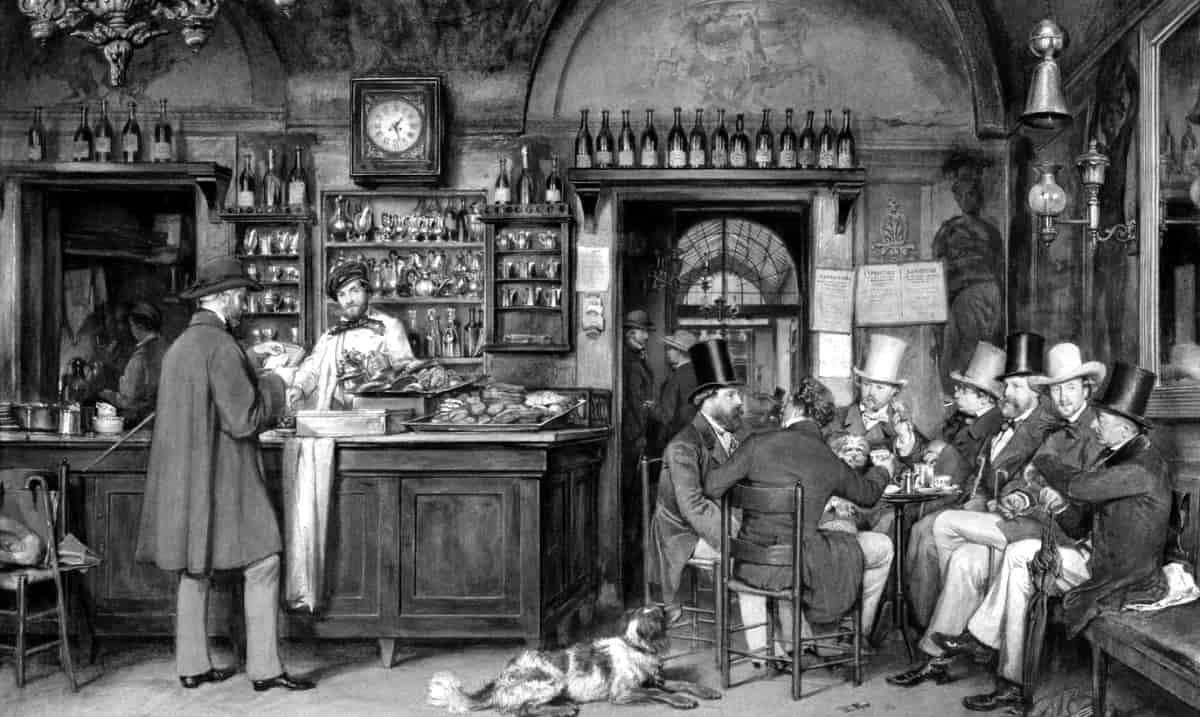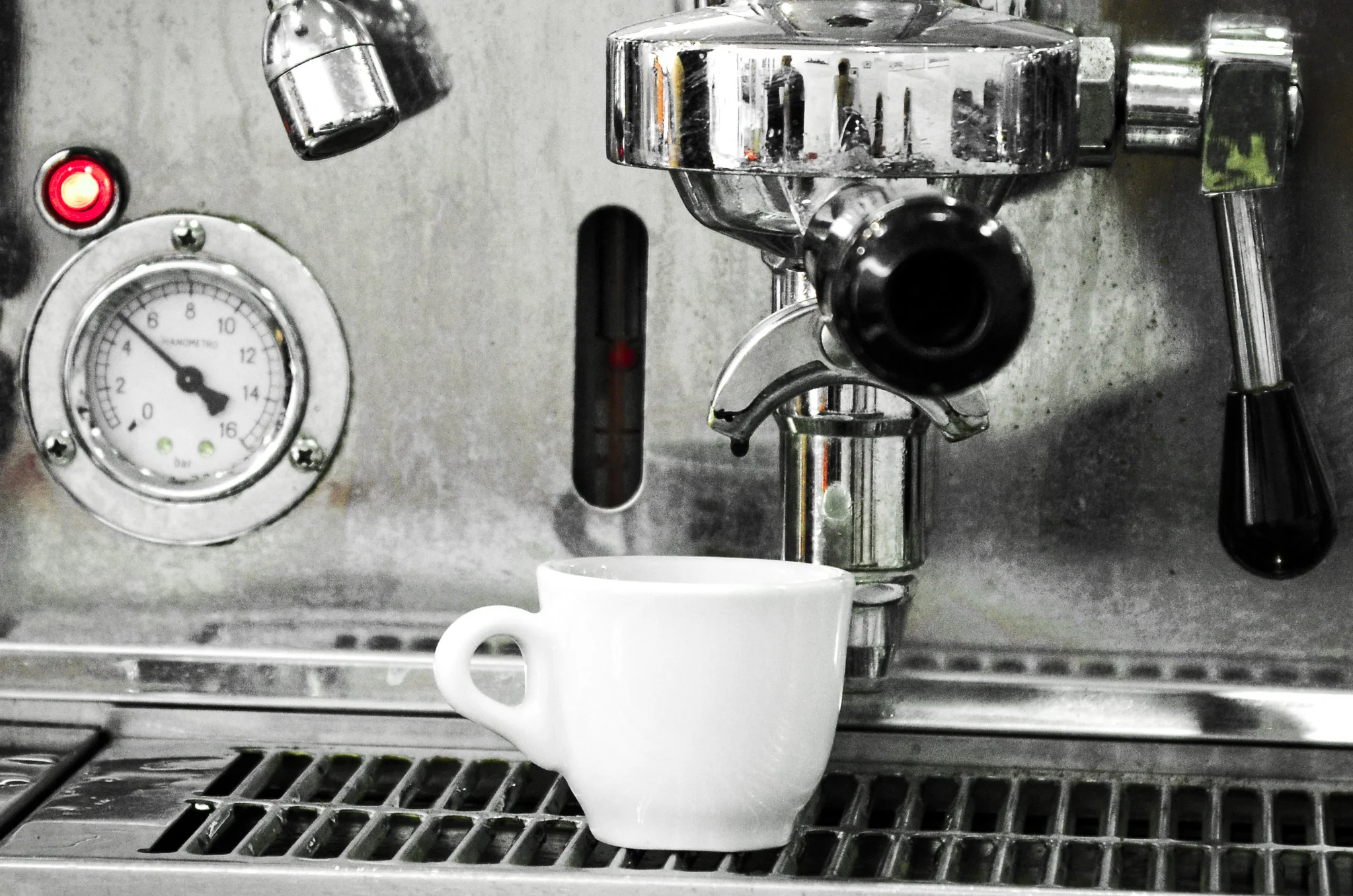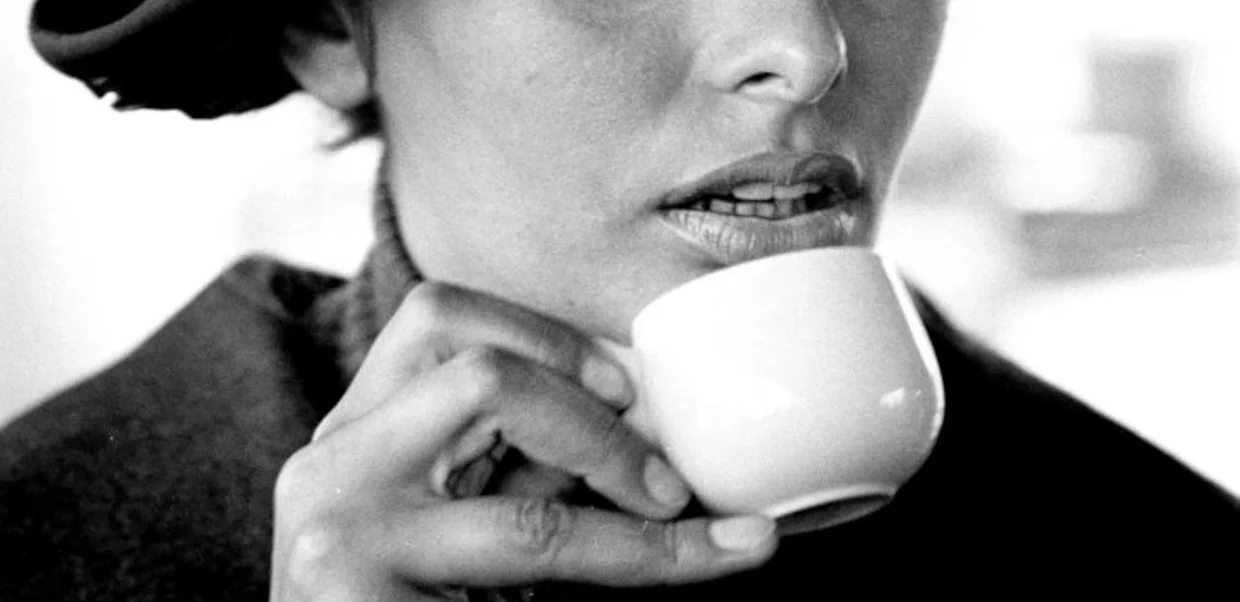In Italy, the kitchen is the heart of the home and coffee is a passion that brings friends and family together, Bialettis Moka pot is found in nine out of ten households. We Italians are passionate about our brew, and as such, there are numerous rules for the preparation that are followed. The legendary Moka Express stove top espresso maker in 1933, revolutionized the way we enjoy our coffee forever.
In this Article
The history & heritage of the Moka pot
The aluminum, eight-sided stove top brewer, has become one of the undisputed symbols of Made in Italy in the world of coffee preparation.
Alfonso Bialetti‘s Moka
Alfonso Bialetti had worked in an aluminum factory in France, and upon returning to Italy in 1918, he started his own aluminum workshop in Crusinallo (Piedmont). It soon turned into a studio for designing and producing finished items using shell molding.
The – aluminum – geyser-type of coffee maker with the octagonal shape was created in 1933 and subsequently patented by Alfonso Bialetti in the 1950s.
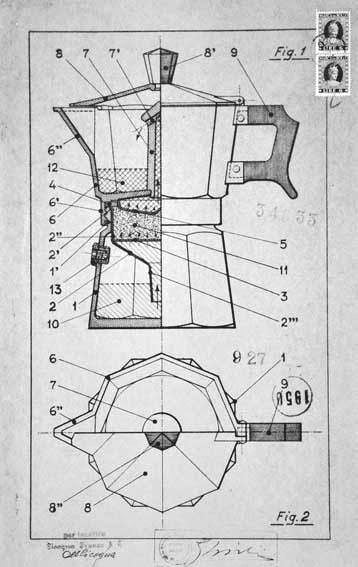


There are a number of accounts that name Luigi De Ponti as the designer and Alfonso Bialetti as the producer of the Moka pot.
Luigi de Ponti was the managing director of Alfonso Bialetti & C., Fonderia In Conchiglia S.P.A. in the 1980s, so after the invention. There is a 1983 patent that lists De Ponti as the inventor of another coffee maker, called Bialetti Termocrem (in the picture)
Renato Bialetti and l’omino coi baffi

Aluminum shortages during World War II (1939–1945) almost doomed the Moka Express, but sales took off again when Alfonso’s son, Renato Bialetti, took over the business.
Renato introduced l’Omino con i baffi – the little man with the mustache, or the mustachioed Man. The characters image was based on Renato himself, is printed on every Moka Express and has become just as iconic as Alfonso’s invention.
Between 1957 and 1977, popularity was greatly boosted by advertising on the Carosello — a 10-minute spot of advertising shown on Italian national TV every night. A more comic segment than advertising, Bialetti’s mustachioed man was a frequent visitor.
The advertising slogan
“Sembra facile” – “It seems easy”
, he is always portrayed with a raised finger as if ordering an espresso.
The Omino, little man, was designed by Paulo Campani in 1953 and became famous thanks to the commercial aired by Carosello, in which the Omino repeated catchphrases such as “See you at the bar! Instead, they all came to my house for coffee,” with his mouth taking the shape of the letters he pronounced.

Marketing campaigns based on the image of l’Omino con i baffi, made it the symbol of the company. It is featured on the brand logo of Gruppo Bialetti Industries, as well as being used on Bialetti brand products.
In the 1950s, coffee was still primarily a beverage of the urban male upper-middle classes, who consumed a significant portion of their daily intake outside the home. Men drank an average of 1.7 cups of coffee a day, whereas women reported an average of 1.3 cups. 50% of all the coffee drunk by men was consumed outside the home, compared with just 14% of that taken by women.
William Lidwell and Gerry Manacsa wrote, in Deconstructing Design:
“The Moka enabled all Italians to make quality espresso at home. With the fall of fascism and the rise of consumerism in the 1950s,’
coffee at home’ also gave women access to the coffee ritual that had previously been barred to them.
Not only could women drink espresso in their homes, they could also drink espresso prepared by their husbands. This reversal of traditional gender roles contributed, literally and symbolically, to women seeking other achievements outside the home.”
Lady…
Cut ties with the old systems
Update your household with the fastest,
most modern,
economical
coffee maker and
you will have an espresso at home, like at the bar
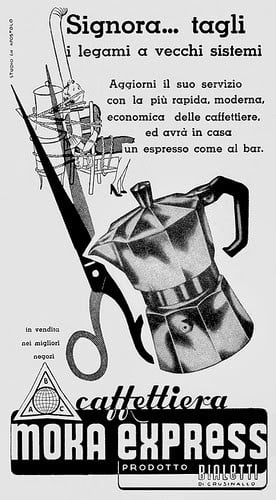
The slogan of the 1950s, for the first advertising campaign of the Bialetti factory was “In casa un espresso come al bar”, which means “In the house, espresso just like the bar”.

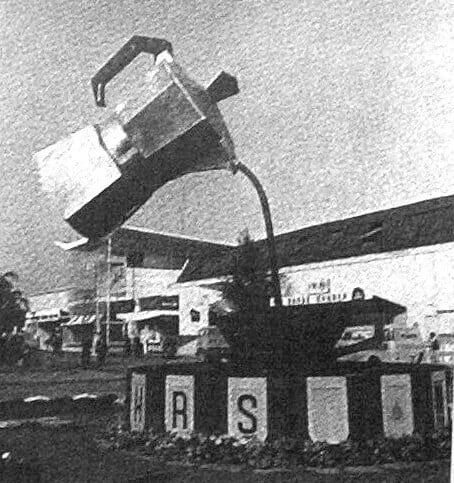
This slogan made the Moka Express famous – the home espresso coffee maker with the unmistakable little man with a mustache printed on it – entered the national lexicon.
Italians were still used to the steam pressured “espresso” machines that dominated the coffeehouse scene and were, therefore, open to home brew solutions that would give them the same style of coffee at home.

Renato Bialetti passed away at the age of 93 on 11 February 2016.
According with the wishes of his children, his ashes were buried in a specially made Moka Express urn.
La Moka express: A tale of Art Deco
The Moka Express, is by far the most common Moka pot sold today and the most recognizable.
Its simple, elegant and recognizable lines, combined with its effectiveness in producing intensely flavored coffee, have made “La Moka” popular. The design was inspired by Art Deco architecture and women’s skirts in the 1930s, says Bialetti Industries export manager Cristina Leporati.


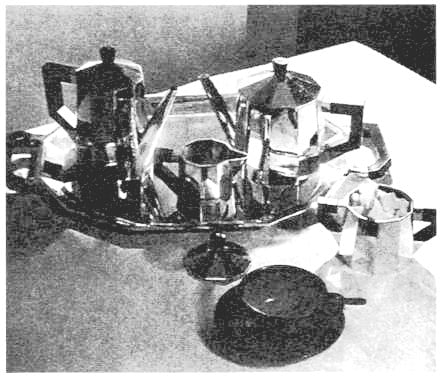
For Jeffrey Schnapp, the Moka Express, design was based on a silver coffee service popular in wealthy Italian homes.
The first models of the Moka were made in aluminum, but over time models in stainless steel were introduced, a material that guarantees greater resistance, durability and prevents corrosion.
The stainless steel Moka also gave the possibility of using the Moka on different heat sources, like induction stoves.
The original design and many current models are still made from aluminum with Bakelite handles.
A design so complete that, over 100 years later, it has hardly changed.
The design has undergone little changes in the 1950s, the handle got an anatomical shape to allow a better grip compared to the 1933 model.

Different sizes were also developed:
1 cup – Capacity: 60 ml

2 cups – Capacity: 90 ml
3 cups – Capacity: 130 ml
4 cups – Capacity: 190 ml
6 cups -Capacity: 270 ml
9 cups – Capacity: 420 ml
12 cups – Capacity: 670 ml
18 cups – Capacity: 810 ml
50 cups – NOT USABLE – for display
An elegant version of the Moka pot in different color variants, called Moka Bialetti Rainbow, was also developed.
This industrial product, is shown in the permanent collections of the Triennale Design Museum in Milan, the London and Munich Science Museum, and the MoMA in New York, making it an icon of Made in Italy.
To date, more than 300 million Bialetti coffee makers have been sold since the mid-1950s.
Known as a “factory of Italian design,” kitchen and home ware brand Alessi has been experimenting with different Moka designs for decades. Some of these are a far departure from the geometric angles of the traditional Bialetti Moka.
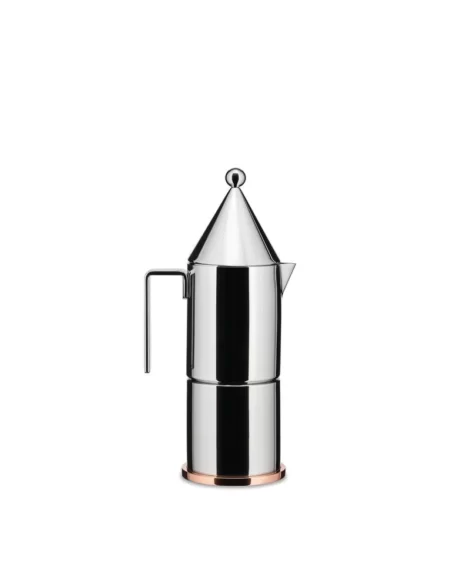
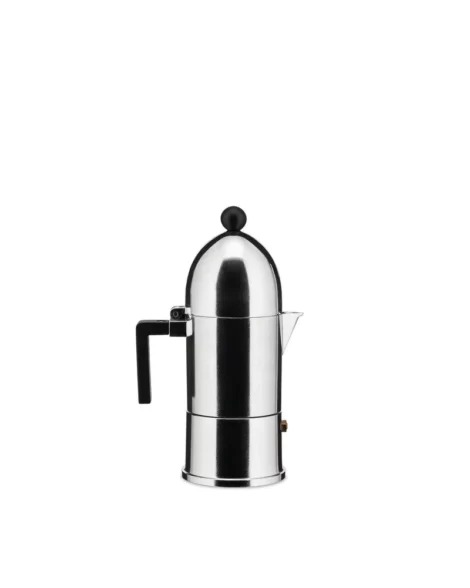
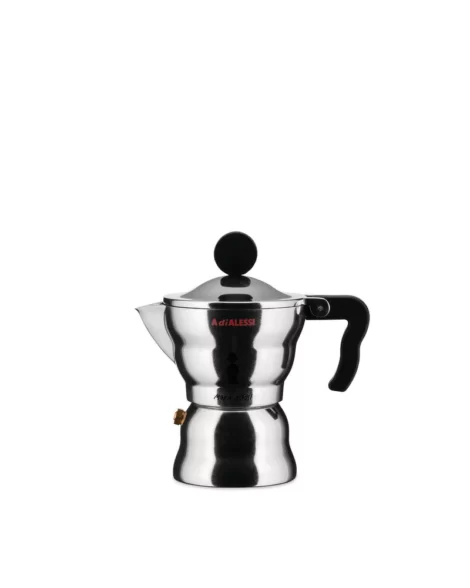



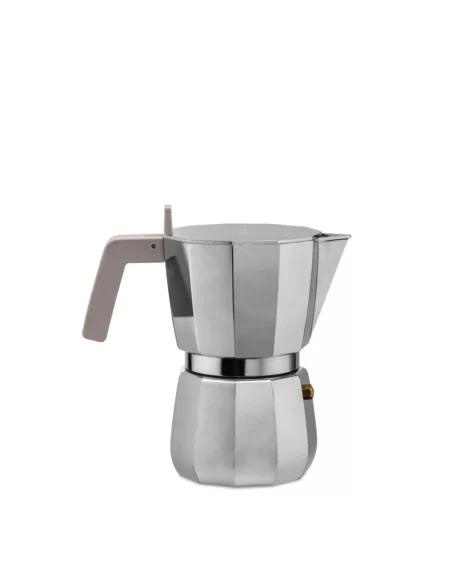
HISTORY: The ancestors of pressurized coffee pots
Experiments with steam pressure brewing having been undertaken in Britain and France as far back as the early 1800s.
Papin’s digester, a pressure cooker
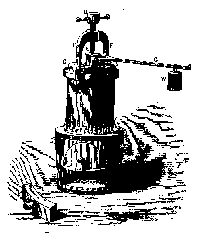
In an article in the Italian newspaper La Repubblica, food historian Massimo Montanari celebrated the invention of what was originally called the
“machine for softening bones.”
This machine, created by Frenchman Denis Papin, was presented to the world in a book published in London in 1681. The bone digester could be used to reduce the time required for cooking foods, thus saving valuable fuel. Papin’s invention, then, was the precursor of the modern pressure cooker. One of the main security problems was the regulation of the pressure inside to prevent explosions. Later versions included a pressure release valve.
Papin’s digester came to Italy soon after its creation, it was popularized by the Venetian Ambrogio Sarotti, used to make medicinal decoctions and broths by a certain Sangiorgio from Milan (prefiguring German chemist Justus von Liebig’s extracts).
This machine not only provided the basis for the pressure cooker: the autoclave, the steam engine, and even the Italian Moka are children of Papin’s genius.
Lisciveuse, an ancestor of today’s washing machine
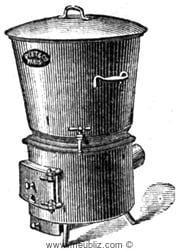
According to legend, during the 1920s Bialetti noticed the laundry methods used by local women. They provided the inspiration for the Moka espresso while watching her do laundry with a lisciveuse.
An ancestor of today’s washing machine was a pot equipped with a tall tube in the center. Cloths were placed in the pot, which was heated so that the hot water, having reached boiling point, would rise in the tube and then fall back on the cloths, taking the soap with it. Through the effect of heat, the soap was dissolved and evenly distributed over the garments. Bialetti’s creation also works under pressure.
Italian Moka Express, the name explained
fast, strong, resistant,
Alfonso Bialetti
like caffeine
MOKA, Mocha or Mokha
The Italian Moka, not only refers to the coffee that comes out of the home coffee maker but also the Yemeni port known in Arabic as Al-Mukha. In English, it is usually rendered as Mocha or Mokha. Alfonso Bialetti chose the name “Moka Express” in reference to this city. Yemen monopolized the world coffee trade for 200 years, shipping tons of sterile beans from the port of Al Mokha.
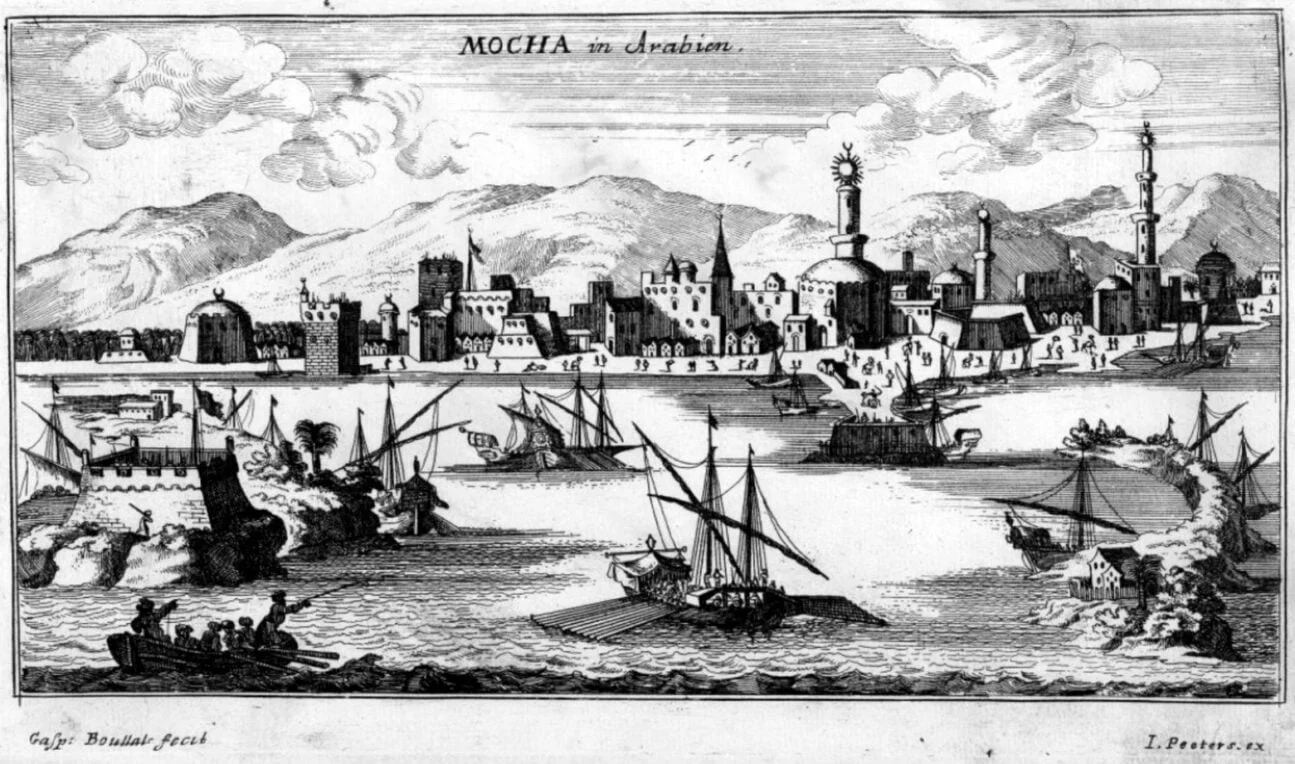
To sound alike is not to taste alike, coffee-style. Italian homemade Moka is not to be confused with British and American mocha drinks, which are based on heated milk, espresso and chocolate or cocoa powder.
In Italy, the term “Moka” has become a synonym for coffee maker. From north to south – la Moka – the moka pot is not just a coffee brewing method but also a symbol of Italy’s distinct and unique coffee culture.
Some of the other names used to refer to la Bialetti, after the Italian inventor and producer Alfonso Bialetti, are a percolator (after its function) or a stove-top coffee maker, and in Italian as
caffettiera (coffee maker), bollitore per il caffè (coffee boiler), or lovingly, la macchinetta (the little machine).
EXPRESS: A tale of speed, messengers, trains and innovation:
The 19th century saw a number of attempts to brew coffee with steam. The goal was to brew a strong cup of coffee very quickly.
Jonathan Morris writes:
The growing demand for coffee outside the home at the end of the nineteenth century led coffee house owners to seek more efficient and economical methods to prepare single cups of coffee for customers. One such was to place a small filter over a cup to produce a caffè express, so called because it was prepared expressly for the customer.
It was, however, Luigi Bezzera of Milan who, in 1901, first registered a patent for a machine equipped with multiple group heads onto which portafilters containing compressed coffee could be clamped, allowing the caterer to brew a fresh cup of coffee “expressly” for a customer by “expressing” hot water drawn from the brass boiler through the coffee cake using the pressure of the steam. Bezzera’s patent was acquired by the manufacturer Desidero Pavoni, whose Ideale machine of 1905 is generally recognized as the first espresso machine to enter commercial production.
The greatest difference to the espresso as we know it today, was that it lacked any of the mousse or crema, due to the low pressures at which it was produced (around 1.5 bar).

Espresso
The word espresso is not a genuinely Italian word. The label was borrowed from the English express via the French expris, meaning something made to order and, by extension, produced and delivered with dispatch, so Jeffrey Schnapp.
Italian lexicographer Alfredo Panzini’s dictionary uses espresso as a term relating to coffee and was rendered in 1931 as:
“Caffè espresso, made using a pressurized machine or a filter, is now commonplace.”

The word express was associated with express messengers, who could be counted upon to deliver messages at speeds superior to those of the ordinary mail service.
This meaning was modified by the rise in mid-nineteenth-century England of special trains running “expressly” to single locations without making intervening stops, trains that soon came to be known throughout Europe as expresses.
The Italian artist Leonetto Cappiello captured this association in the 1922 advertising poster created for “La Victoria Aduino”, a manufacturer of espresso machines.
Historian Jonathan Morris states: The habit of using the term caffetteria (caffetiere) as slang for a slow train as opposed to the fast espresso is indicative that the emphasis placed on the speed of the espresso process has caught the popular imagination.
Espresso is a method of brewing coffee.
The crema revolution changed espresso
JT Schnapp explains:
The new espresso machines were designed to dazzle through their size and speed, with rumbling boilers, brass fittings, enameled ornaments, vulcanized rubber knobs, and gleaming metallic lines all at the command of the caffeinated double of the train conductor-engineer – the barkta.
At the same time, major manufacturers of espresso machines, such as La Pavia, Cremonesi, and Gaggia were also experimenting with steam pressure in their inventions. They focused on large bar machines made of brass, copper, and steel. The high-pressure, lower-than boiling-water solutions of these companies were to take years to develop.
Bar – espresso machines finally produced a great espresso with a thick and creamy crema in 1947, when Gaggia registered a new patent for a lever-operated piston incorporating gearing and a spring. The slogan on the Gaggia machine was –
“Crema caffè naturale”

Today, crema (the word has passed into English) is seen as the defining sensory characteristic of espresso; however, at the time, the new beverage was renamed crema caffè, cream coffee, in order to distinguish it from the extractions produced by the pre-existing espresso machines.
Espresso was no longer plausible for Moka coffee, one look at the cup, which lacks any crema, makes this clear.
Now, the term classic Moka espresso is used to distinguish espresso coffee made with a moka stovetop from the home- or bar – espresso machines of today. However, a typical Moka coffee is extracted at relatively low pressures of 1 to 2 bar (100 to 200 kPa) while standards for espresso coffee specify a pressure of 9 bar (900 kPa).

Cremina per Moka e Napoletana
I’ll share you a tradition from the south of Italy – the secret how to get a crema on your coffee prepared with a Moka or a Napoletana. Our friend Silvia, from Brunico send us this recipe:
All you need is sugar and a spoon.
Use 6 teaspoons of granulated sugar for 3 coffees and a few drops of coffee. Put the sugar in a cup. Prepare the coffee as usual and put it on the stove. As soon as the coffee starts to rise, remove the pot from the heat and pour the first few drops of coffee (which are the creamiest and have the most intense flavor) into the bowl with the sugar.
Return the mocha to the stove over low heat. With circular movements, mix sugar and coffee with a teaspoon until a sufficiently thick cream is obtained. The stronger the mixture is stirred, the frothier the coffee cream will be. Put a teaspoon of cream in each cup and then pour over the coffee.
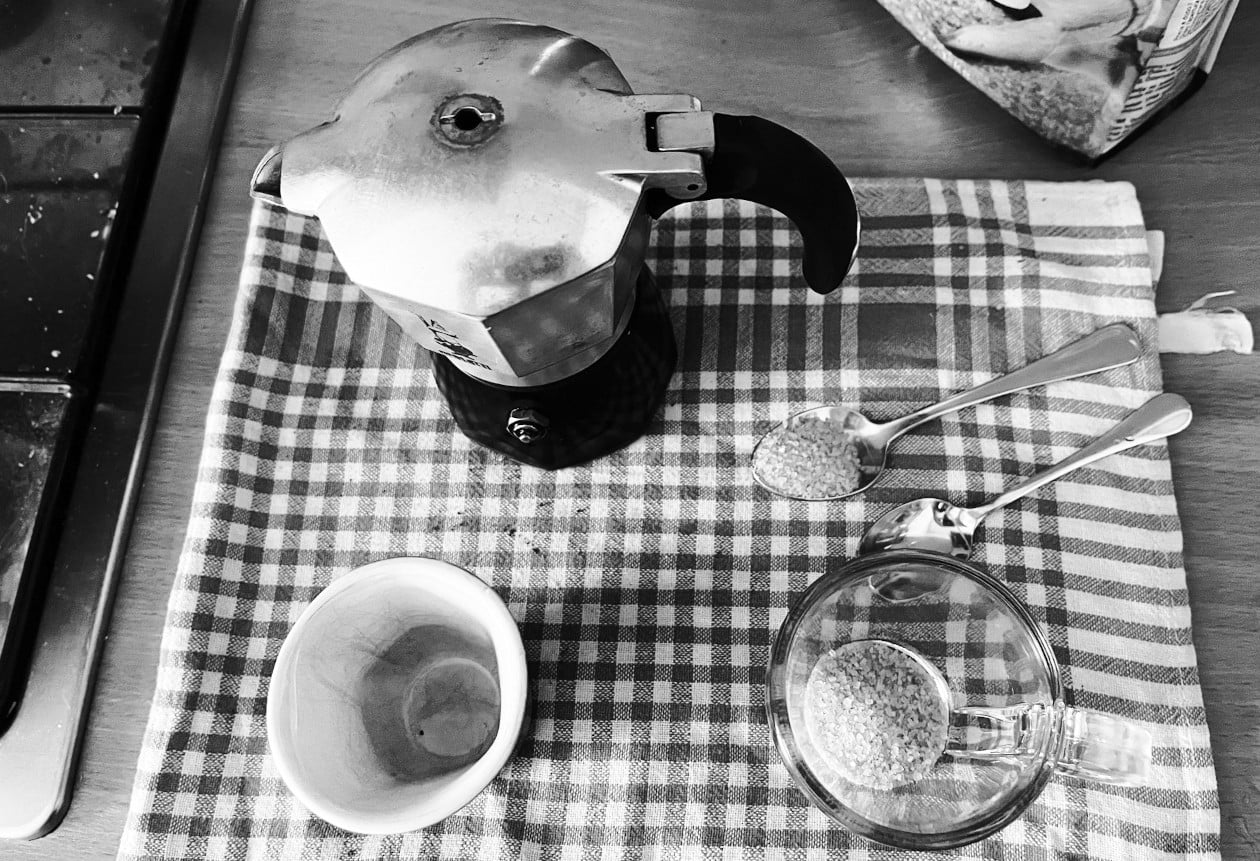
Our friend Augusto from Napoli puts the sugar directly into the coffees stove pots upper chamber, to get a sweet coffee cremina.
Enjoy your caffè con crema.
The Bialetti Mukka express, allows for milk to be frothed and mixed with the coffee during brewing.

The Bialetti Brikka Moka pot is one of the modern alternatives to the original Moka Express.
It is notable for the added pressure valve (Cremator or Cremavent) that is designed to produce a crown of crema.
The result is coffee brewed at a higher pressure and temperature than the standard pot, making it more similar to espresso and therefore with more visible crema.
Making Moka Coffee – the classic moka espresso ritual
The Parts of the Moka:

The removable filter is held in place by a rubber or latex gasket. The mechanism of the Moka is linked to its structure and its components. These are:
- the bottom chamber, a boiler that acts as a base;
- a funnel filter with a plate;
- an upper chamber where the coffee is collected.
These are the essential elements. There are other important components such as the valve and the gasket.
The seal and removable filter are to be changed periodically.
How to prepare a classic Moka coffee (Stovetop Espresso)
Matteo Paris, professor of the Physics department of the University of Milan, explains:
At the boiling temperature of water,
the pressure inside the tank of a three-cup coffee maker would be around 1700 atmospheres,
and this would mean that most Italians keep a small number of dangerous bombs in their own homes.
The number is not small – as many as 3 Moka pots are sold every minute…
The physics of the Moka coffee maker
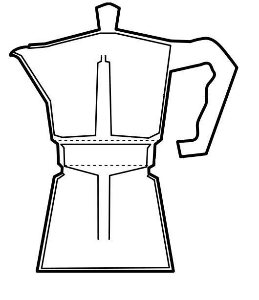
Many have an hourglass shape, but you can find Moka pots in a variety of styles, all based on the same operating principle. Water is heated in a lower chamber. Vapor pressure approaching two atmospheres pushes the water up through ground coffee in a filter, which collects in the upper chamber as liquid coffee.
Two physicists Andrei Varlamov and Attilio Rigamonti, explain the curious preparation of coffee:
The water in the tank of a coffee maker evaporates only minimally: the heat from the stove heats both the water in the tank and the thin layer of air above it.
As the air warms up, its pressure increases, because the molecules of which it is composed move faster, and therefore it tends to expand. The expansion of the air compresses the water in the tank, which has the filter spout as its only outlet.
As a result, the water rises and flows through the coffee powder, transforming into the elixir we all know, as it finally reaches the upper collection vessel.
According to several studies on steam pressure coffee extraction, the pressure that takes place in the Moka pot (about one to two bars) is nowhere near as strong as that of a bar espresso machine (nine bars). With the Moka you can make a concentrated shot of coffee.
The Bailetti marketing slogan,
“Oh, yes, yes… it seems easy (to make good coffee)!”
became a catchphrase. Every morning, every time we prepare a moka pot at home, physics, in addition to our preparation skills, helps us to perform a rite, that of the cup of classic moka.
The iconic Omino con i baffi , “the little man with the mustache” shows how easy it is to make a macchinetta:


Gambero rosso, has a 7 step guide on his website compiled by Lucio Del Piccolo, a collector of coffee makers for years engaged in promoting the correct use of the Moka, through conferences, events and through his blog Caffettiere e Macchine da Caffè. For the guide that follows, we will rely on his words:
The 7 steps to a state-of-the art coffee made with a moka pot
Water: It’s best to use filtered or mineral water because the higher the concentration of dissolved salts in the water, the lower the quantity of good fat substances that will be extracted. On temperature there are two schools of thought: at room temperature, or hot, as other professionals in the sector say, including Alberto Polojac, Italian Moka champion and importer of raw coffee. In any case, what matters is the “cleaning” of the water, that is with the least amount of chlorine possible.
Water level: As for the quantity, it’s good to keep to the water level just below the valve. A level that can sometimes be reduced, but never surpassed. The valve is used to vent steam: if you cover it with water, it will be blocked and only water will come out.
Coffee grind: We will never tire of repeating it: regardless of the chosen extraction, whether it’s a “simple” Moka pot, a Napoletana or a filter coffee, the grains must be ground at the moment. After about 15 minutes from grinding, in fact, the product has already lost about 65% of its aromas.

The coffee: The most classic and popular blend in Italy, which varies depending on the area, is 30/70, with 30% Robusta and 70% Arabica. But a good cup can be prepared (most advisable) even with a single origin or a 100% Arabica blend.
Coffee quantity: Let’s finally tackle the ages-old question: heaped yes, heaped no? The univocal answer is: no! First of all because, when the coffee pot is screwed together, the powder settles on the edges and ends up on the seal gasket: without good sealing between the two parts, the coffee is extracted badly. And then, because of the brew ratio between water and coffee, which usually – for a 3-cup Moka – is 1:10. So, about 15 grams per 150 milliliters of water. If you increase the amount of coffee powder, some of the soluble compounds – the most bitter and unpleasant ones that we would otherwise lose – end up in the cup.
The gurgle: A little patience and finally the pot begins to murmur, warning us that the extraction is complete. Yes, because when the gurgling begins, our coffee is already done, and that intriguing set of aromas that begins to spread around the house is nothing but an amalgam of fragrances that we’re losing from our cup. The ideal, therefore, is to stop the extraction a bit before the gurgling sound, when the drink reaches about three quarters of the pot, so as to retain most of the aromas.
The flame: A medium flame is ideal for the preparation of a Moka pot. Once the flame is turned off before the gurgling sound, the coffee pot should be removed from the hob to completely block the extraction.
Using Bialetti Coffee Makers – Brew Guide from the New Zealand website:
Bialetti aluminum and stainless steel stove top coffeemakers work on a pressure based system.

- Before using the coffeemaker for the first time, unscrew the top from the base.
- Remove the funnel from the base. Then remove the filter plate and the ring.
- Wash all parts in warm water and correctly reassemble the top section.
- Fill the base with water to just below the level of the safety valve. Be careful not to overfill as the air in the space between the water and the coffee filter is what heats and forces the water up through the coffee. If the water tank is overfilled the result is boiled coffee, with a bitter or burnt taste.
- Insert the funnel.
- Loosely fill the funnel with your favorite ground coffee (we recommend a medium-fine grind. Medium-fine will feel gritty when rubbed between your fingers, not powdery. Note that a espresso grind purchased from a store for electric espresso machine’s is typically too fine and may block your Bialetti).
Do NOT tamp coffee down. Remove any coffee grounds on the edge of the funnel. - Screw the top section firmly to the base. Avoid using the handle for leverage.
- Place the coffeemaker on a low to medium heat. This is most important for induction cook tops as they will quickly overheat the pot if on a high setting. When using on gas adjust the flame so that it does not extend up the side of the pot potentially burning the handle or paintwork.
- It takes only 3 – 6 minutes, depending on the size of the coffeemaker and the intensity of heat, until it’s ready to serve.
- Remove immediately from the heat once coffee pot is full. Do not allow to boil and do not put on full heat as this may cause the coffee to have a burnt taste.
- Gently give the coffee a stir before pouring.
- All Bialetti stove top espresso makers are suitable for use on gas, electric and ceramic hobs. Stainless steel models are also additionally suitable for induction.
Illy caffè s Step by step guide to Moka coffee
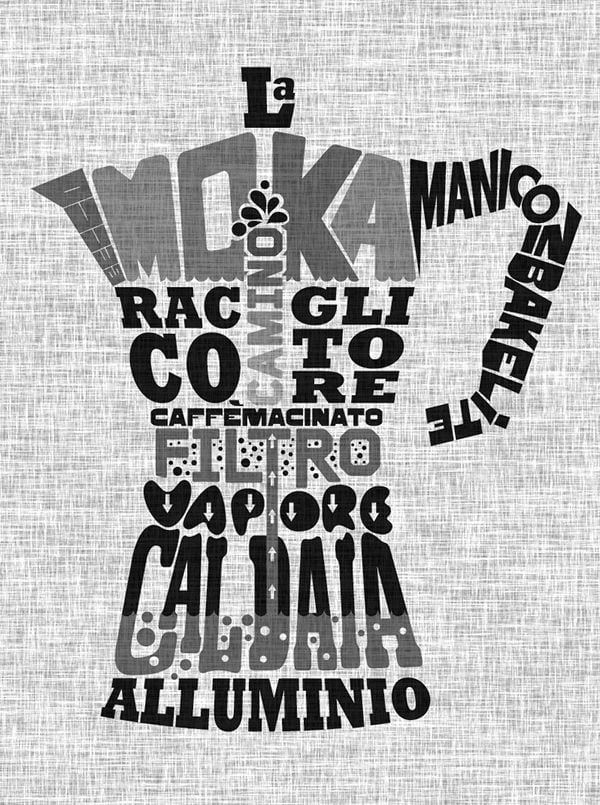
Fill the base chamber with cold water up to the level of the valve. Insert the filter.
Completely fill the filter with ground coffee, but don’t pack it down.
Make sure the filter and rubber gasket are in place. Screw the two chambers tightly together.
Place the Moka pot on the stove. Keep the heat low.
Remove pot from heat just when coffee starts to gurgle, before it starts to rise and bubble. You’ll be sure to extract only the best parts of the coffee.
Mix the coffee with a spoon before pouring into cups.
Rinse the coffee maker with hot water and let dry thoroughly before screwing chambers back together.
Lavazza, has some interesting coffee hacks explaining how to make Espresso at home with a Moka Pot

Place Moka pot on heat
Place the Moka pot on low to medium heat on a stovetop. If you are using an electric stovetop with a large surface area, you may want to place the Moka pot to the side with the handle facing away from the heat. This helps to avoid the handle heating up too much.
Remove Moka pot from heat immediately after first bubble
Wait for the Moka pot to start brewing the coffee. Leave the lid open. You will see a consistent stream of brewed coffee flow through to the top chamber of the Moka pot. When this stream stops flowing consistently and bubbles begin to appear, immediately remove the Moka pot from the heat and and place the bottom chamber in a bowl of room temperature water to cool it.
Taste your coffee
Pour it into your serving glass/cup and enjoy!
If it is sour, you have under extracted and should use a finer grind.
If it is bitter, you have over extracted the coffee and you should use a slightly coarser grind.
If it is not unpleasantly bitter or sour, your grind size was appropriate and you can consume this coffee (delicious)
Family secrets to obtain the perfect Moka
The Moka machine is treated with care and love.

Everyone has their own recipe, jealously guarded and handed down from generation to generation. Imprecise by nature, the Moka is an instrument that’s difficult to be taught, and yet there are some easy rituals for a best result.
And, just like in the case of Moka, these are not always that obvious. Every Italian family has got their own traditions on how to use the machine and we used to share the tricks and secrets to obtain the perfect beverage.
A great blend
Is one’s own favorite coffee brand, the blend that most closely matches one’s taste. Bialetti:
Be aware though, not all blends are the same. In order to prepare an exquisite espresso, coffee grounds must be of good quality. First of all, one must consider the choice of the blend. Roasting is then an important phase: this is the moment in which the coffee’s aroma flourishes. A long and controlled roasting process enhances the entire aromatic spectrum of the coffee. Finally, pay attention to the type of coffee bought. It may seem obvious, but it is important to make sure that you actually buy coffee for Moka pots.
Unlike for espresso machines, coffee for the Moka is a coarser grind. While analyzing how the Moka works, the size of the coffee grounds deserves a special mention. A calibrated grinding, carried out specifically for the Moka allows you to make a full-bodied, creamy coffee, characterized by its aromatic intensity.
A clean Moka

I was taught that coffee tastes better when made in an old Moka, one that has been used regularly, so I learned to respect the old machines, rather than wanting a shiny new one. The residue of coffee from previous brews, taints the side of the Moka pot and some believe, that it adds flavor and depth, that’s why it is recommended that you don’t clean it too thoroughly.
Thus it is washed delicately with hot water, rising every part after the use (never soap or other detergents, sometimes lemon).
Bialetti states, that in order to preserve the taste of the blend, the oils and grease deposited on the surface of the Moka need to be eliminated, because these are oxidized and burned over repeated usage. Never reassemble if not dry to avoid oxidation.
Deeper periodic cleaning, ensures that the coffee maker is always in its full glory and always functions at its best. If the filter plate of the filter plate’s holes are clogged, they can be cleaned using a toothbrush with delicate bristles or the tip of a needle. To clean the bottom chamber of the Moka fill the boiler with water.
Add two teaspoons of citric acid or vinegar.
Reassemble the Moka pot and, without adding any coffee powder, brew. Discard the obtained solution. Wash the coffee pot with running water and proceed with the preparation of the coffee. For effective cleaning of the gasket, simply remove it from the Moka and wipe its entire surface with a cloth soaked in water.
Use baking soda, vinegar and citric acid to remove limescale.
A small initiation ceremony
With a brand new Moka there are a few simple steps to follow:
- Thoroughly rinse the Moka pot with water and, for the first time, use it only with water without adding any ground coffee;
- Make at least 3 coffees: not to be consumed but necessary to best enhance the aroma of the coffee in the Moka.
The classic Italian grandmother’s advice is what actually makes the difference. The oils and waxes present in the ground coffee create an insulating and protective coating inside the Moka pot. An invisible element, but of great importance.
The Moka is now ready to accompany you. If not forever, for a long time.

The “wet bed” technique
Lucio Del Piccolo, a coffee maker collector who has been involved for years in promoting the correct use of the moka, through conferences, events and through his blog “Caffettiere e Macchine da Caffè”, explains – La tecnica del “letto bagnato” – the “wet bed” technique:
His special technique is designed to counteract the excessively high temperature that the drink reaches at the moment of bubbling,
“around 100 degrees, while the ideal one is around around 92/93°C”.
The procedure is simple: just remove a little water from the boiler and, once the coffee has been inserted into the filter, pour it over the powder, so that the temperature drops by at least 6/7°C, then proceed with the extraction.
One last piece of advice? To best savor all the aromas released, it is advisable to drink the coffee as soon as it is poured into the tazzina, the demitasse cup.
The Moka is recognized as one of the symbols of Italy.
About 90% of Italian families own and use a Bialetti Moka coffee maker.

History & heritage of the Moka pot

Some families have more than one. It is an iconic machine and part of the daily routine for the majority of Italians. Every household has one (or several, according to every occasion): a small one-cup Moka to make yourself a cup of coffee in the morning or after lunch; a big moka to make coffee for all your friends and family at the end of a dinner party; a moka in the office or in the holiday house; a little moka to use when traveling. That is exactly why we have a travel moka, it wouldn’t be home without it.
Turning on the stove, waiting for the characteristic gurgling that heralds an eruption of aromatic coffee. The muttering sound that all Italian homes share in the morning — that sound and scent that evoke family memories, care and the many deserved breaks from a busy life.
Means memory and hospitality.

This historic Italian coffee maker remains timeless
the “machinette – small machines” do not just make coffee: they make tradition, they make memories, they make perfume, they make music, they make us happy, they make us nostalgic, they make us feel like family even if we are far from home.

~ ○ ~
Keep exploring:
Works Cited & Multimedia Sources
The history of coffee is an extraordinary study. If you would like to learn more about it, I heartily recommend the book, All About Coffee, by William Ukers. Written in 1928, it will delight you with detail.
- Allegra World Coffee Portal www.worldcoffeeportal.com
- Artusi Pellegrino. Science in the Kitchen and the Art of Eating Well, transl. Murtha Baca and Stephen Sartarelli. 2003.
- Biderman Bob. A people’s history of coffee and cafés. 2013.
- Café Culture Magazine www.cafeculturemagazine.co.uk
- Carosello Bialetti: la caffettiera diventa mito https://www.famigliacristiana.it/video/carosello-bialetti-moka-mito.aspx
- Cociancich Maurizio. Storia dell’ espresso nell’Italia e nel mondo. 100% Espresso Italiano. 2008.
- Coffee Connaisseur www.coffeeconnaisseur.com
- Coffee Geek www.coffeegeek.com
- Coffee Origins’ Encyclopedia www.supremo.be
- Coffee Research www.coffeeresearch.org
- Coffee Review www.coffeereview.com
- Coffee Sage www.coffeesage.com
- Coffeed.com www.coffeed.com
- Comunicaffe International www.comunicaffe.com
- Davids Kenneth. Espresso Ultimate Coffee. 2001.
- De Crescenzo Luciano. Caffè sospeso. Saggezza quotidiana in piccoli sorsi. 2010.
- De Crescenzo. Luciano. Il caffè sospeso.
- Eco Umberto. “La Cuccuma maledetta” in Agostino Narizzano, Caffè: Altre cose semplici. 1989.
- Global Coffee Report www.gcrmag.com
- Gusman Alessandro. Antropologia dell’olfatto. 2004.
- Hippolyte Taine, wrote in, Italy: Florence and Venice, trans J. Durand. 1869.
- http://www.archiviograficaitaliana.com/project/322/illycaff
- http://www.baristo.university/userfiles/PDF/INEI-M60-ENG-Public-Regulation-EICH-v4-1.pdf
- http://www.coffeetasters.org/newsletter/en/index.php/category/a-baristas-life/
- http://www.coffeetasters.org/newsletter/it/index.php/il-galateo-del-caffe/01524/
- http://www.culturaacolori.it/fascismo-contro-le-parole-straniere/
- http://www.espressoitaliano.org/en/The-Certified-Italian-Espresso.html
- http://www.inei.coffee/en/Welcome.html
- https://archiviostorico.fondazionefiera.it/entita/585-bialetti-industrie
- https://bialettistory.com/
- https://cdn.intechopen.com/pdfs/55623.pdf Severini Carla. Derossi Antonio. Ricci Ilde. Fiore Anna Giuseppina. Caporizzi Rossella. How Much Caffeine in Coffee Cup? Effects of Processing Operations, Extraction Methods and Variables
- https://en.wikipedia.org/wiki/Drip_coffee#Cafeti%C3%A8re_du_Belloy
- https://en.wikipedia.org/wiki/ISSpresso
- https://en.wikipedia.org/wiki/Italian_meal_structure
- https://en.wikipedia.org/wiki/Neapolitan_flip_coffee_pot
- https://hal.science/hal-00618977/document
- https://hub.jhu.edu/magazine/2023/spring/jonathan-morris-coffee-expert/
- https://ineedcoffee.com/the-story-of-the-bialetti-moka-express/
- https://it.wikipedia.org/wiki/Caff%C3%A8
- https://it.wikipedia.org/wiki/Caff%C3%A8#Risvolti_etici_e_sociali
- https://it.wikipedia.org/wiki/Napoletana
- https://italofonia.info/la-politica-linguistica-del-fascismo-e-la-guerra-ai-barbarismi/
- https://italysegreta.com/italian-hospitality-the-invite/
- https://library.ucdavis.edu/wp-content/uploads/2022/06/LangPrize-2017-ElizabethChan-Project.pdf
- https://memoriediangelina.com/2009/08/11/italian-food-culture-a-primer/
- https://mostre.cab.unipd.it/marsili/en/130/the-everyday-eighteenth-century
- https://napoliparlando.altervista.org/cuccumella-la-caffettiera-napoletana/
- https://specialcoffeeitaly.com/barista-espresso-coffee-machine/
- https://specialcoffeeitaly.com/italian-breakfast-cappuccino-cornetto/?_gl=1*1gjfoya*_ga*OTE0MDM2ODM5LjE2OTMzNjE5OTg.*_ga_2HTE5ZB0JS*MTY5MzM2MTk5Ny4xLjEuMTY5MzM2Mjk0NS4wLjAuMA../
- https://specialcoffeeitaly.com/what-came-first-the-italian-bar-or-coffee/
- https://themokasound.com/
- https://uwyoextension.org/uwnutrition/newsletters/understanding-different-coffee-roasts/
- https://www.adir.unifi.it/rivista/1999/lenzi/cap2.htm
- https://www.bialetti.co.nz/blogs/making-great-coffee/using-bialetti-coffee-makers
- https://www.bialetti.com/ee_au/our-history?___store=ee_au&___from_store=ee_en
- https://www.bialetti.com/it_en/inspiration/post/ground-coffee-for-moka-should-never-be-pressed
- https://www.brepolsonline.net/doi/pdf/10.1484/J.FOOD.1.102222
- https://www.coffeeartproject.com/TheCollection/Amsterdam/2014.aspx
- https://www.coffeeartproject.com/TheCollection/Amsterdam/2014.aspx
- https://www.coffeeartproject.com/TheCollection/Milan/2013/Gallery/Other/Amalia-Chieco
- https://www.coffeeartproject.com/TheCollection/NewYork/2016.aspx
- https://www.coffeeartproject.com/TheCollection/NewYork/2017.aspx
- https://www.coffeeartproject.com/TheCollection/NewYork/2018.aspx
- https://www.coffeeartproject.com/TheCollection/NewYork/2019.aspx
- https://www.coffeeresearch.org/science/aromamain.htm
- https://www.coffeereview.com/coffee-reference/from-crop-to-cup/serving/milk-and-sugar/
- https://www.comitcaf.it/
- https://www.ecf-coffee.org/wp-content/uploads/2023/05/European-Coffee-Report-2022-2023.pdf
- https://www.espressoitalianotradizionale.it/
- https://www.euronews.com/culture/2022/02/15/the-italian-espresso-makes-a-bid-for-unesco-immortality
- https://www.faema.com/int-en/product/E61/A1352IILI999A/e61-legend
- https://www.finestresullarte.info/en/works-and-artists/the-bialetti-moka-the-ultimate-romantic-design-object
- https://www.finestresullarte.info/opere-e-artisti/moka-bialetti-oggetto-design-ultimi-romantici
- https://www.freemalaysiatoday.com/category/leisure/food/2022/02/15/italy-woos-unesco-with-magic-coffee-ritual/
- https://www.gaggia.com/legacy/
- https://www.gamberorossointernational.com/news/coffee-10-false-myths-to-dispel-on-the-beverage-most-loved-by-italians/
- https://www.gcrmag.com/calls-to-review-price-structure-of-italian-espresso/
- https://www.granaidellamemoria.it/index.php/it/archivi/caffe-espresso-italiano-tradizionale
- https://www.illy.com/en-us/coffee/coffee-preparation/how-to-make-moka-coffee
- https://www.illy.com/en-us/coffee/coffee-preparation/how-to-use-neapolitan-coffee-maker
- https://www.ilpost.it/2011/06/08/itabolario-bar-1897/
- https://www.itstuscany.com/en/bar-where-the-word-comes-from/“Cafe Hawelka”, John A. Irvin
- https://www.lastampa.it/verbano-cusio-ossola/2016/02/17/news/le-ceneri-di-renato-bialetti-nella-sua-moka-con-i-baffi-1.36565348/
- https://www.lavazza.com/en/coffee-secrets/neapolitan-coffee-maker
- https://www.lavazzausa.com/en/recipes-and-coffee-hacks/making-espresso-at-home
- https://www.linkedin.com/pulse/third-wave-coffee-meets-tradition-neapolitan-maker-bruno-lopez
- https://www.mumac.it/we-love-coffee-en/be-our-guest-en/progettazione-e-rito/?lang=en
- https://www.quartacaffe.com/images/pdf/carta-dei-valori.pdf
- https://www.repubblica.it/il-gusto/2021/07/26/news/caffe_il_piu_clamoroso_equivoco_gastronomico_d_italia-311835974/
- https://www.taccuinigastrosofici.it/ita/news/contemporanea/semiotica-alimentare/print/Pop-cibo-di-sostanza-e-circostanza.html
- https://www.thehistoryoflondon.co.uk/coffee-houses/
- https://www.wien.gv.at/english/culture-history/viennese-coffee-culture.html
- Illy Andrea. Viani Rinantonio. Furio Suggi Liverani. Espresso Coffee. The Science of Quality. 2005.
- Illy Andrea. Viani Rinantonio. Furio Suggi Liverani. Espresso Coffee. The Science of Quality. 2005.
- International Coffee Organization www.ico.org
- Kerr Gordon. A Short History of Coffee. 2021.
- La cremina per il caffè: come farla bene. https://www.lacucinaitaliana.it/news/cucina/come-fare-la-cremina-del-caffe/
- Lee Stewart Allen. Devil’s Cup. A History of the World According to Coffee. 1999.
- Leonetto Cappiello – Wikipedia page on the creator of the 1922 poster La Victoria Aduino.
- Markman Ellis. The Coffee House. A Cultural History. 2005.
- Mennell Stephen. All Manners of Food. Eating and Taste in England and France. 1996.
- Montanari Massimo. Il riposo della polpetta e altre storie intorno al cibo. 2011.
- Montanari Massimo. Il sugo della storia. 2018.
- Morris Jonathan. A Short History of Espresso in Italy and the World. Storia dell’espresso nell’Italia e nel mondo. In M. Cociancich. 100% Espresso Italiano. 2008.
- Morris Jonathan. Coffee: A Global History. 2019.
- Morris Jonathan. Making Italian Espresso, Making Espresso Italian.
- National Coffee Association www.ncausa.org
- Pazzaglia Riccardo. Odore di Caffe’. 1999.
- Pendergrast Mark. Uncommon Grounds. The History of Coffee and How It Transformed Our World. 2019.
- Perfect Daily Grind www.perfectdailygrind.com
- Scaffidi Abbate Mario. I gloriosi Caffè storici d’Italia. Fra storia, politica, arte, letteratura, costume, patriottismo e libertà. 2014.
- Schnapp Jeffrey. The Romance of Caffeine and Aluminum. Critical Inquiry. 2001.
- Sibal Vatika. Food: Identity of culture and religion. 2018.
- Specialty Coffee Association www.sca.coffee
- Spieler Marlena. A Taste of Naples. 2018.
- Tea and Coffee Trade Journal www.teaandcoffee.net
- The Long History of the Espresso Machine. www.smithsonianmag.com
- The Pleasures and Pains of Coffee by Honore de Balzac
- The relaxation ritual https://themokasound.com/
- Tucker, Catherine M. Coffee Culture: Local Experiences, Global Commensality, Society and Cuture 2011.
- Virtual Coffee www.virtualcoffee.com
- World Coffee Research www.worldcoffeeresearch.org

